Bast fibers have been highly regarded for beautiful, durable textiles throughout history and into the modern era. Over the past year, Fibershed’s Lead Process Engineer Nicholas Wenner has been connecting with bast fiber growers, researchers, processors, and artisans to better understand the state of soil to soil systems for these unique plants. This series examines and documents a range of bast fibers, which derive from the tissue in the outer layer of certain plant stems, including those of flax, hemp, nettle, and dogbane. In the plant, the hollow fibers transport dissolved sugars and lend structural support for the stem. In textiles, the fibers provide strength and many other unique properties. As crops, the plants can play a valuable role in crop rotations and provide high yields of both food and fiber with relatively minimal inputs.
Photography by Paige Green and as noted.
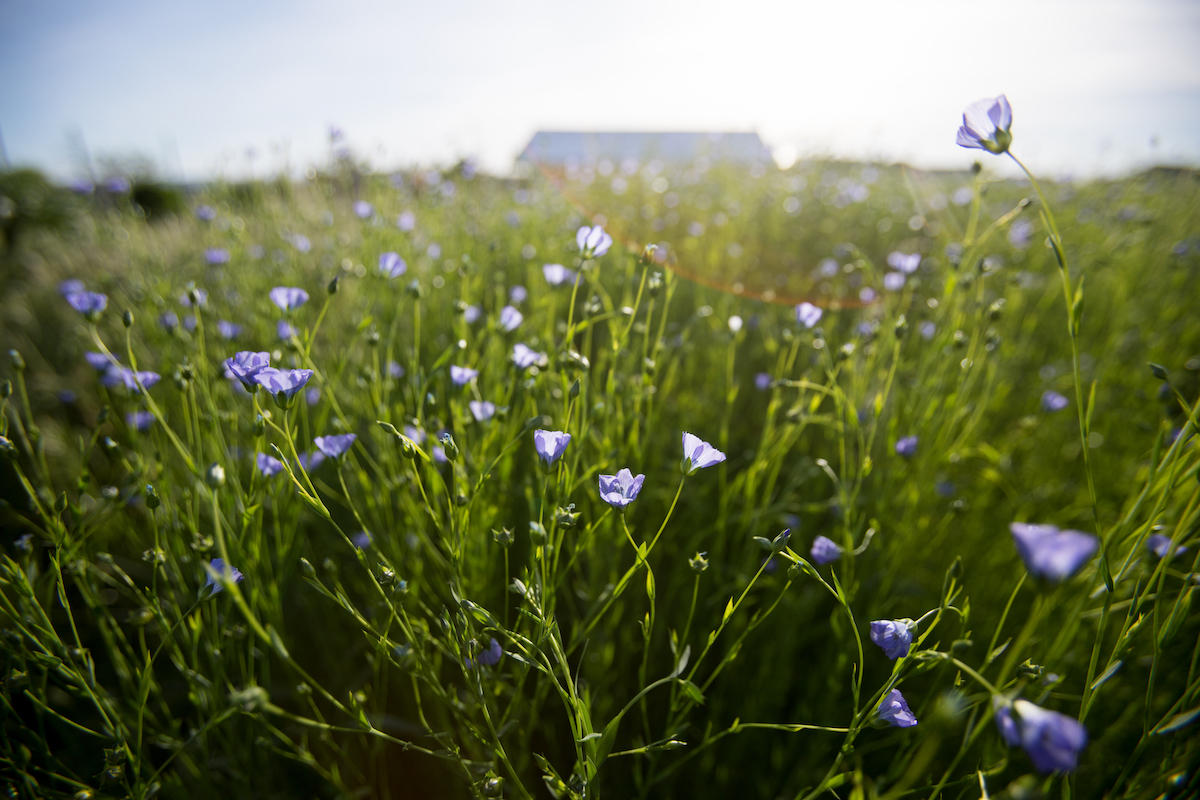
Originating in the Fertile Crescent, the flax plant Linum usitatissimum has been cultivated for its seeds and fiber for more than 5,000 years. Wild relatives of this plant have been used for food and fiber for tens of thousands of years.
Flax has a long history in the United States and—until recently—was grown and processed throughout the country. Oregon’s climate is particularly well-suited to the plant, and the flax industry flourished there for nearly 100 years, peaking during World War II with about 18,000 acres in production and 14 processing plants in operation. By the 1960s, however, post-War loss of subsidies and competition from synthetic fibers and from cotton had put an end to commercial growing and processing of flax in the state.
Two groups on the West Coast, Chico Flax in the Sacramento Valley of California and Fibrevolution in the Willamette Valley of Oregon, are now leading the revitalization of the flax textile industry in the region. Groups in other regions of North America, such as the Cleveland Flax Project in the Rust Belt Fibershed, are also doing this work.
Chico Flax was started in 2010 by Sandy Fisher and Durl Van Alstyne to pilot regenerative agricultural production and processing systems for fiber flax in Northern California, bringing a new industry and social enterprise to the region in collaboration with local community members, farmers, artisans and institutions.
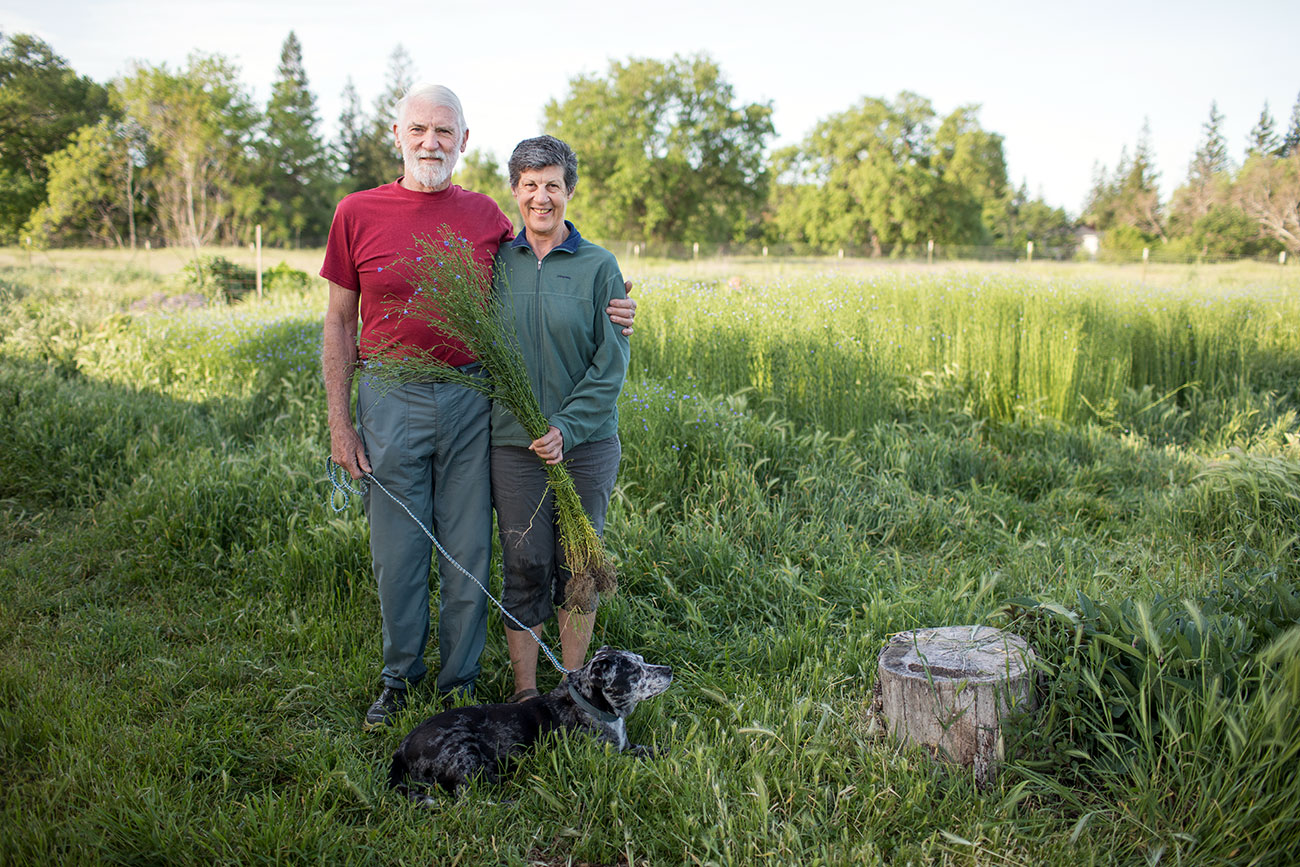
Durl Van Alstyne and Sandy Fisher of Chico Flax (Photo by Paige Green)
Fibrevolution was formed by Shannon Welsh and Angela Wartes-Kahl in 2016 to build a regional farming network in the Pacific Northwest centered around a bast fiber processing facility for both flax and hemp and rooted firmly in organic practices.
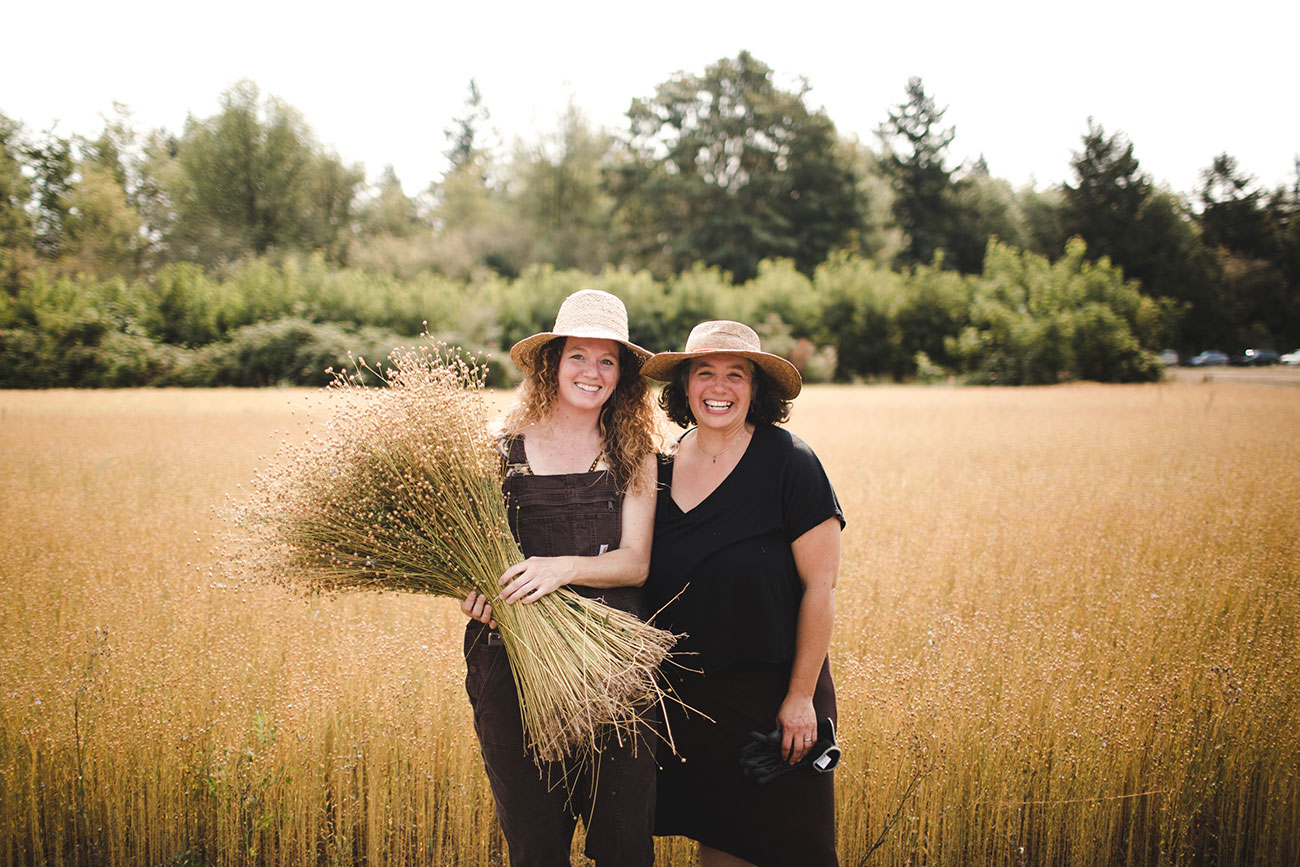
Shannon Welsh and Angela Wartes-Kahl with their 2017 flax crop at harvest time (Photo by Micah Fischer)
Flax offers many advantages as a crop. In addition to providing fibers for linen, a high strength fabric that is both quick drying and cooling, it provides flax seeds for food and oil and plays many valuable agricultural roles. As Fibrevolution shares from their experience in Oregon: “Flax matures quickly in just 100 days. It is an excellent crop to include in rotations with other cereals, grass seed, alfalfa, and oil seed crops. As part of a holistic farm plan to maximize crop production while sequestering carbon, a fiber flax crop can follow vegetables, cereals, cover cropping, or intensive rotational grazing. Fiber flax’s high seeding rate suppresses weeds, and once pulled for harvest leaves a clean field for the next crop without the use of herbicides. It needs very little water to grow, and generally, irrigation is not required for flax unless temperatures are very high after the flowers appear.”
We’ve asked both Fibrevolution and Chico Flax to provide updates on their recent efforts below:
Fibrevolution Updates
by Shannon Welsh
Our fieldwork this season was supported by a Patagonia Environmental Grant award in partnership with Pacific Northwest Fibershed / Fibershed.
This growing season we focused on seed development, field retting research and working with the state of Oregon to develop a strategic plan to guide and get the bast fiber industry going and moving in the right direction. With the approval of the 2018 farm bill, hemp fiber has become a huge topic of interest. We have developed a plan that would allow us the ability to advise our region on bast fibers (both flax and hemp), how these crops work within rotation of one another as well as share processing infrastructure and the capital needed to build both the flax and hemp fiber industry. It’s a historic time for fiber in the USA!
We partnered with Nathaniel Powell-Palm of Cold Springs Organic Farm, to grow our Organic fiber flax seed this spring at his farm outside of Bozeman, Montana. Nate started farming when he was just 12 years old as part of a grant for a 4-H project. While a junior in high school he applied for Organic certification for his cattle operation in Montana, making him the state’s youngest certified Organic farmer for many years. Since then he has expanded his farm, Cold Springs Organics, into crop production and today is a proven leader in Organic agriculture. Nate planted 5 acres of our Willamette Valley-grown Linore fiber flax seed in Montana in Spring 2019. After a successful growing season the organic fiber flax seed crop was successfully harvested in August 2019 and is currently awaiting cleaning.
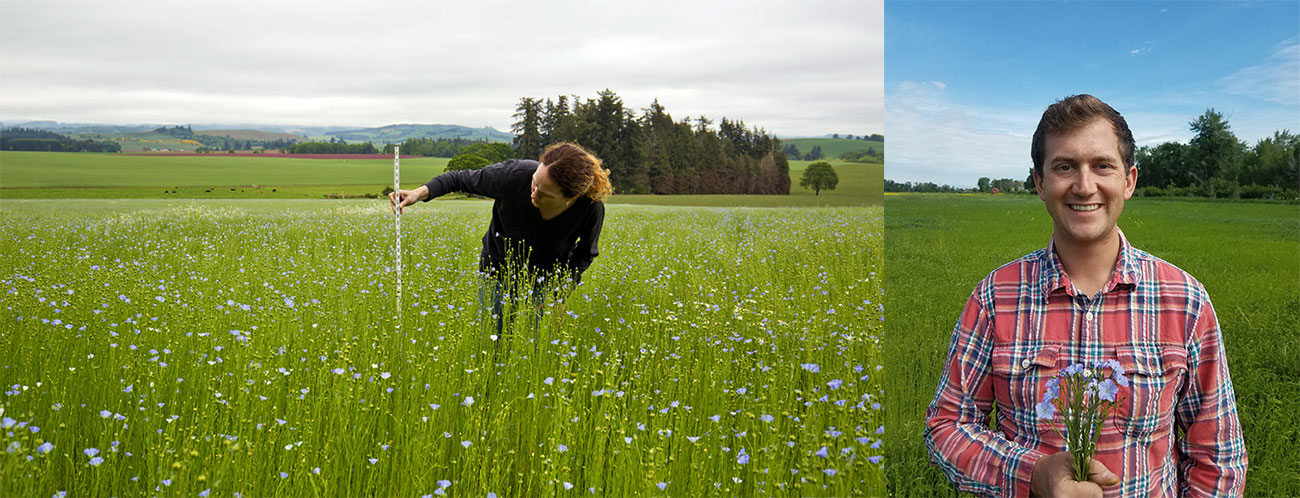
Left, Shannon Welsh measuring flax growth in test plots in the Willamette Valley of Oregon; right, organic farmer Nathaniel Powell-Palm, who grew seeds for Fibrevolution this year at his farm in Bozeman, Montana (photos from Fibrevolution)
Earlier this year, we produced a video with plant breeder Jennifer G. Kling about her fiber flax seed breeding program. In 2019, our fiber flax seed breeding plots grew organically and without irrigation. They were overwintered in the Willamette Valley of Oregon in Albany, meaning they were seeded in the Fall of 2018.
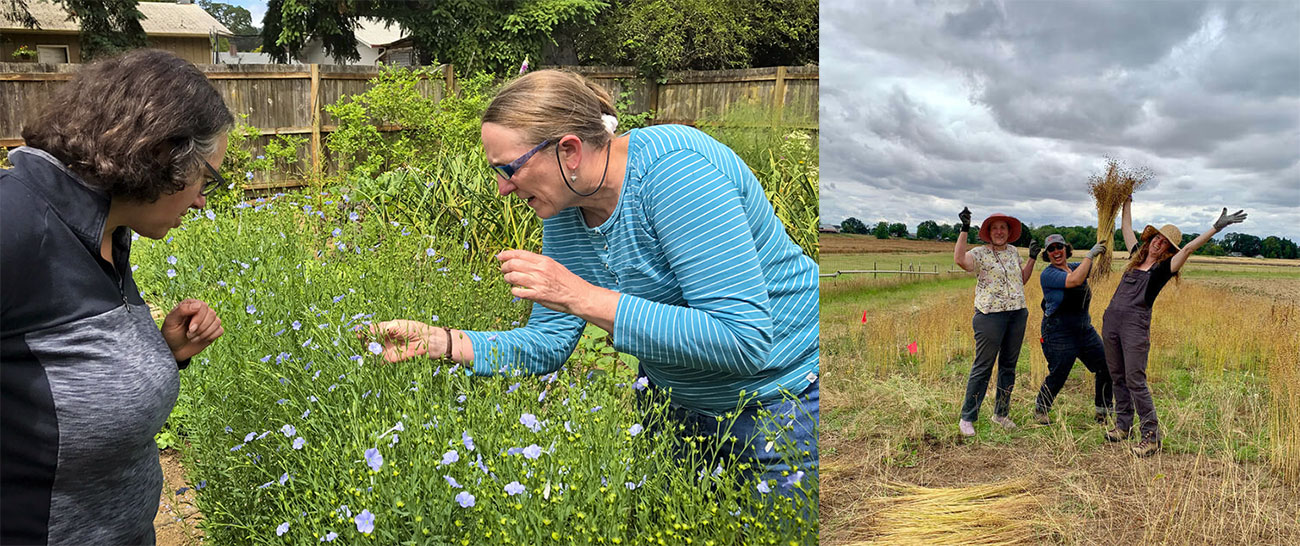
Left, Angela Wartes-Kahl and Jennifer G. Kling inspecting seed breeding plots in the Willamette Valley of Oregon; right, Jennifer G. Kling, Angela Wartes-Kahl, and Shannon Welsh after harvesting successful 2019 seed breeding plots (photos from Fibrevolution)
All seed was successfully harvested. After seed selections for the breeding program were made, the remaining plants were pulled and rippled to remove seed pods, and the remaining fiber flax stalks were left in the field to rett. Field retting trials from these plots were successful. We found that overwintering fiber flax in the Willamette Valley of Oregon is a viable and desirable growing practice for our region to limit water usage and the need to irrigate.
We planted a small trial plot of two fiber flax varieties at Vibrant Valley Farm on Sauvie Island this season. Those crops grew well and were part of a demonstration plot for Portland Textile Month. We held a 4-hour workshop on Sept. 8 at Vibrant Valley Farm, where they have been growing and up-scaling their indigo plots. They have become leaders in our area for indigo, from field to pigments and dyes. The workshop we held was very well attended, with 26 people who traveled from Japan, California, and Washington to learn and explore both linen and indigo. Everyone had the opportunity to explore both indigo and flax in the fields as well as hand process and dye fabric. The event was a huge success and we plan to host more opportunities like this in collaboration going forward.

People, flax, and indigo come together at a workshop at Vibrant Valley Farm on Sauvie Island in Oregon
(Left photo from Fibrevolution, right photo by Caleb Sayan)
Our goal for flax in the 2020 growing season is to scale up crop production of fiber flax. After multiple growing seasons and research, we have protocols in place for growing, harvesting and field retting our crops at a larger scale. We have also made great strides in attracting the partners we need to build infrastructure and acquire seed and harvesting equipment. We also have a large number of experienced farmers ready to add fiber flax into their crop rotations. This is a very exciting time for the revitalization of linen in the Pacific Northwest!
Chico Flax Updates
by Sandy Fisher
This year we made great strides forward in our vision to grow, process, and produce a fine quality fiber flax here in Northern California. The Fall of 2018 got off to a late start for planting for two reasons: First, we had to prepare our land (an old almond orchard) for planting as we met the requirements of our CDFA Healthy Soils Incentives Program grant, planting over 1,000 California native plants in a hedgerow. Second, we were delayed by the catastrophe of the Camp Fire. Even after the fire, the air quality was so bad we postponed our planting dates from October until early December. Due to the late start the cooler temperatures of December hindered the germination of our flax. When the warmer weather came in February and lots of rain that spring, the flax just couldn’t catch up. What we harvested by April was a shorter plant. We clearly saw the difference when we compared the experimental area on the farm where students from the California State University Chico (CSUC) agriculture department planted flax in September and October. All of the varieties grew to the full 36 to 40 inches in height.
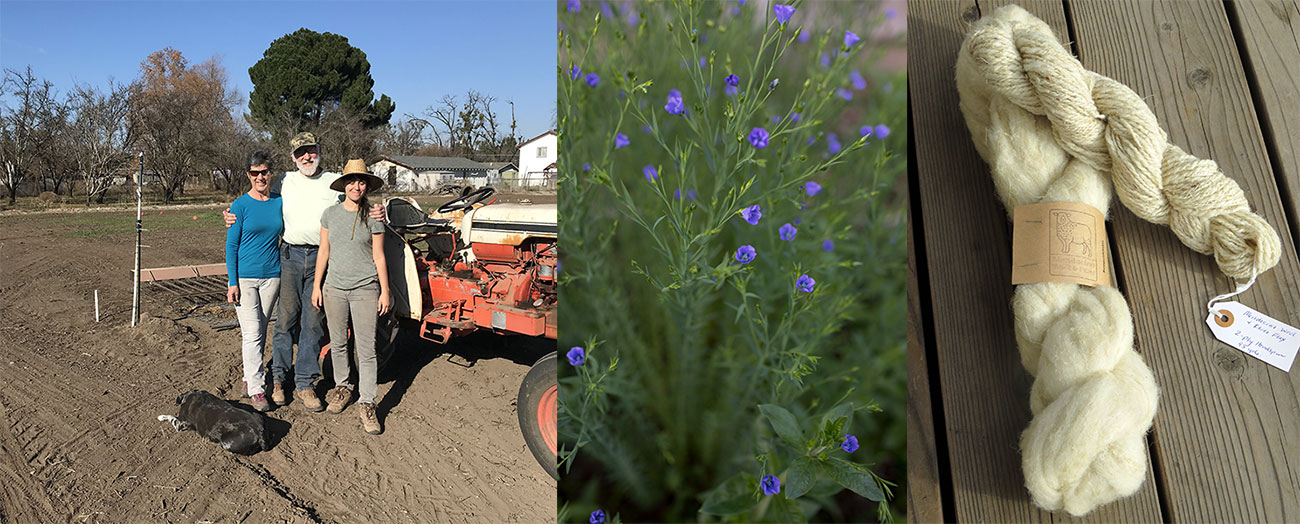
Left: Sandy Fisher, Durl Van Alstyne, and volunteer Samantha Claghorn preparing Chico Flax’s fields for planting (photo from Chico Flax); center: flax growing at Chico Flax (photo by Paige Green); right: roving and yarn (35% flax/65% wool) produced with Chico Flax’s 2018 flax fiber at Mendocino Wool and Fiber Inc. (photo from Chico Flax)
Before the harvest we worked with Mendocino Wool and Fiber Inc. of Ukiah, California to create a blended flax/wool yarn using last year’s fiber. By the time of our Spring Harvest Festival we had available a 35% flax / 65% wool roving which we sold at our event.
By April, our harvest began, and volunteers came for several days from all over California to help us hand-pull our flax. By the end of April, we hosted our first Spring Harvest Festival, with over 100 community members coming from near and far to tour our farm, learn about CSUC student research, and to hear from myself and Durl about our vision for our farm.
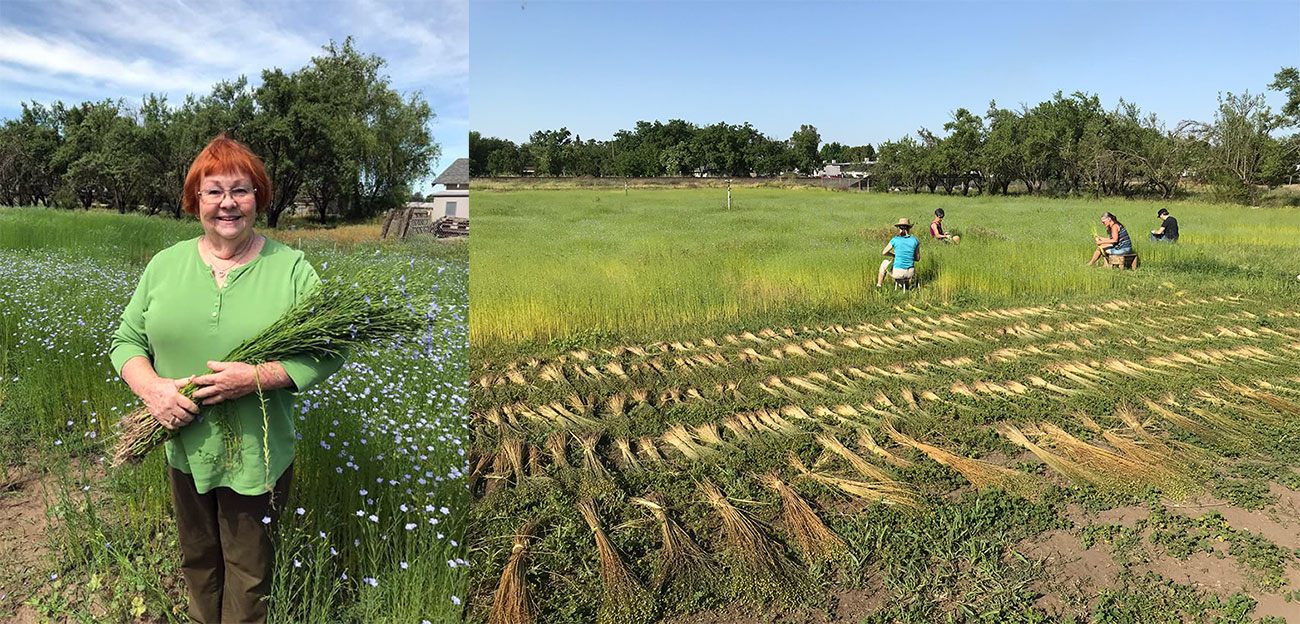
Volunteers help harvest the 2019 crop (photos from Chico Flax)
This year, we were more motivated than ever to process all of our harvest after the successful collaboration with the Mendocino mill earlier in the year. Hiring three individuals for four weeks we were able to hand-process over 750 pounds of flax into straw, tow and fine long line fiber.
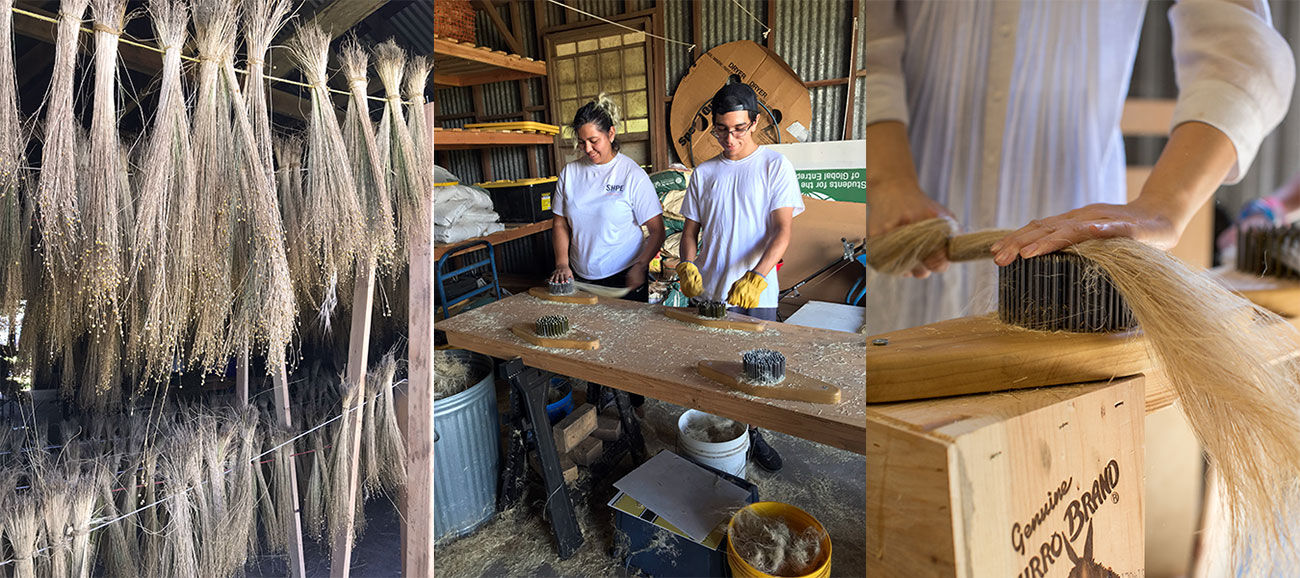
Left: Flax stalks dry in the barn (photo from Chico Flax); center and right: Chico Flax hired local workers to hand-process over 750 pounds of harvested flax this year (center photo from Chico Flax, right photo by Paige Green)
The straw is available for papermaking, the tow was sent to the Mendocino mill for spinning (minus 5 pounds which was sent to North Carolina for blending with Sally Fox’s brown cotton, which will be available early next year for sampling), and over 30 pounds of high quality “Estate Blend” long line fiber has been made available for hand-spinning. Much to our delight, Mendocino Wool and Fiber Inc. is creating a high quality flax/wool yarn with the tow fiber we sent using their newly commissioned spinning equipment. The yarn is now being put up into 2-ply sport weight skeins and will be ready for market by January 2020. All these products will be available on our website: www.chicoflax.com.
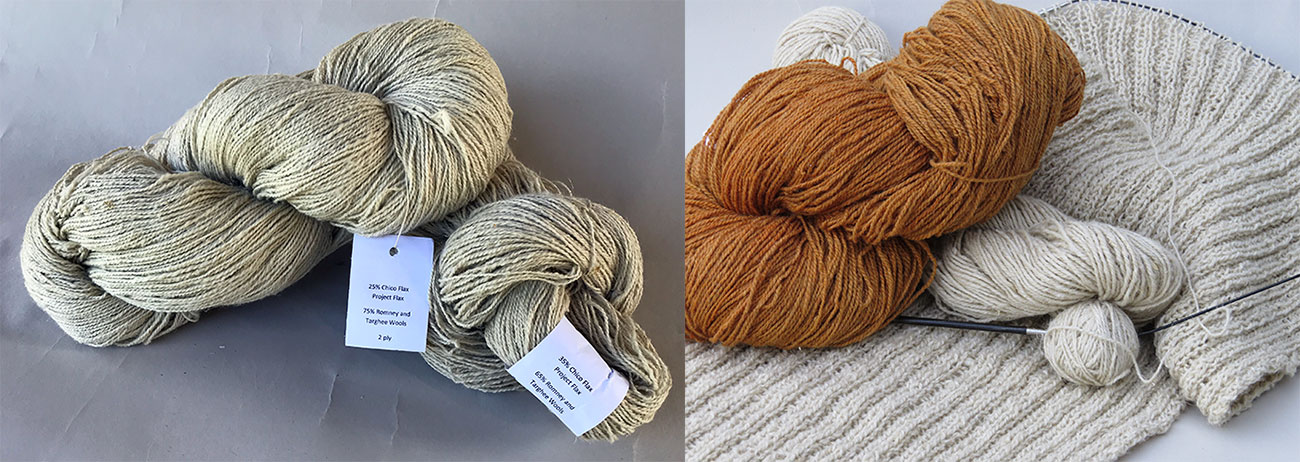
Blended yarns using Chico Flax’s 2019 flax fiber and local wool will be available for purchase online in early 2020. Yarns are spun by Mendocino Wool and Fiber Inc. The dyed skein was dyed with coreopsis by Heather Podoll. (photos from Chico Flax)
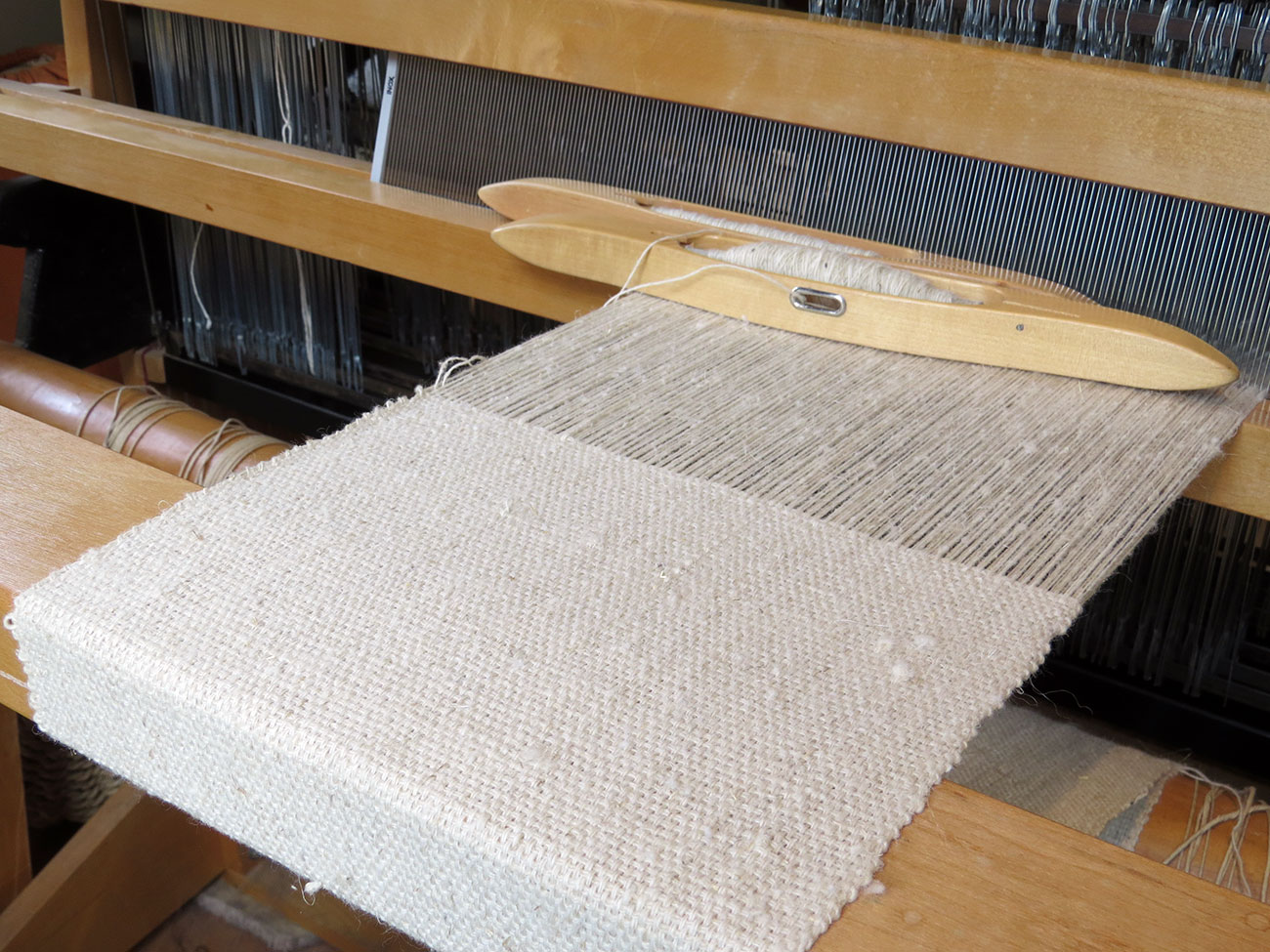
Hand-woven flax/wool cloth produced by Sandy Fisher using flax from Chico Flax’s 2019 harvest (Photo from Chico Flax)
As CSUC’s Spring semester was coming to an end, we received a phone call from a professor who had worked with us previously to create a final project in his mechanical engineering class for a prototype mechanical flax brake. With our guidance, a team of four students created a small functional brake. This introductory project led to an invitation to participate in the fall and spring semesters of CSUC’s 2019/2020 Capstone Design Program, where we are working with a team of four seniors to create the first mechanical brake/scutch made in California to our knowledge. This tool will be ready by May of 2020. What this means for us is that all of this year’s crop will be processed by an efficient machine rather than with the colonial era tools we have been using.
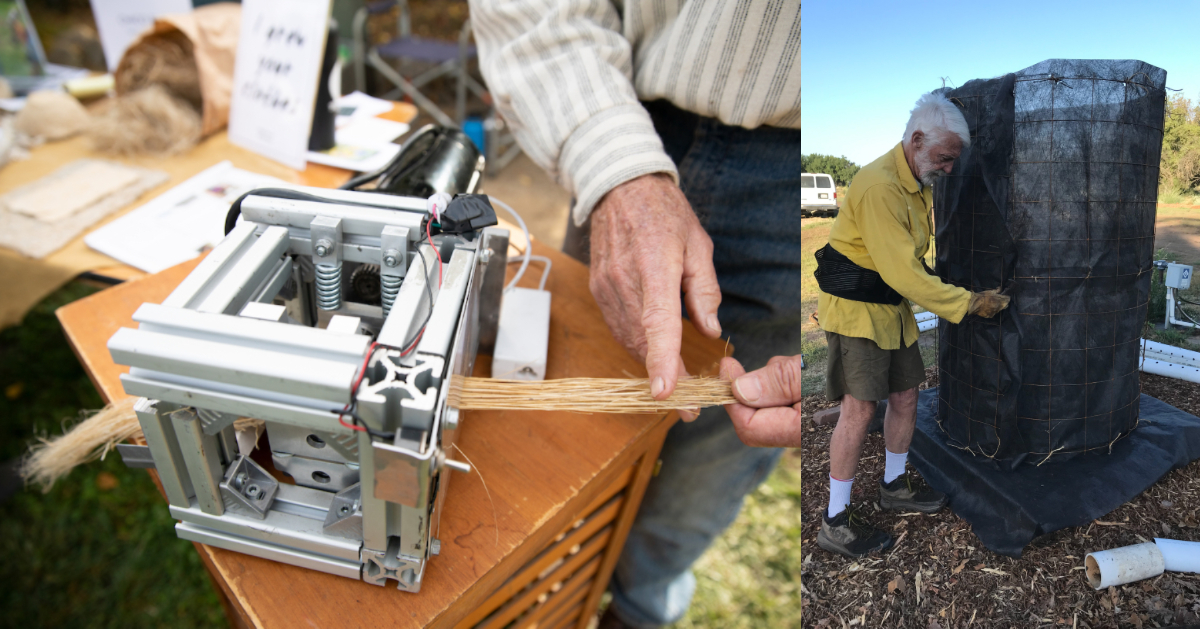
With our Fall 2019 planting complete, we expect 4000 pounds of straw next year. As the year progresses we will continue our experimentation with cover crop varieties and soil testing for carbon sequestration through our Healthy Soils Program grant. We will also add to soil microbial health by creating compost using a Johnson-Su Bioreactor we built this summer. We are exploring several grants to support our soil improvement practices and our visions for creating Chico Cloth, becoming a research center for flax in Northern California, and developing a mini-mill on-site.





